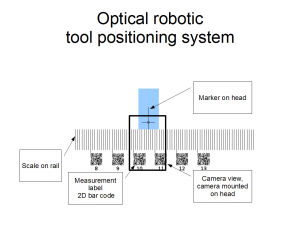3D Printer / CNC head positioning ideas
Ideas to make high precision low cost head positioning systems for 3D printer / fabricators / CNC machines. Precision stepper motors are expensive. What if you could use cheap analog motor? They could be very fast and cheap.
Electrical Resistance
Run a length of wire along each axis of the printer / fabricator / CNC and measure the resistance at the head position. Using a table of actual resistance measurements on the device could increase accuracy and even heat differences could be taken into account. This could be extremely accurate and low cost.
Optical
Optical is another approach, this is how mechanical mice and mane printers function. Using a digital camera with distance measurements on a scale printed from a long format printer could make the device very fast and accurate. Using optics the accuracy could increased fine precision even with cheap webcam sensors.

RF Triangulation
Mounting an RF transmitter on the head and antennas at the corners of the tracks could allow triangulation of the head to extremely high precision even over very large distances. This is the same technique used by GPS and cell phone towers. The precisions scales with size and frequency transmitted.
Electrical Balancing
Using opposing electrical currents to create a balance for any location along the rail. With the correct calibration this can be very accurate plus provide very fast movement.
Ham boning robot, Abundance Report
Meat cutting is a dangerous, physically stressful, and tedious job. Replacing human meat cutters with robots is all around better if the humans have an income.
The representative repeatedly says the robots can cut oddly shaped soft objects. He is making clear that cutting ham is not the only use. The robot can cut a wide variety of foods but also non-food. They’ve likely chosen ham boning as their first task because the size makes it easier than smaller or more delicate food like fish and improving ham processing is higher value than vegetables. Defining the goal properly and finding the best entry to the market is very important for innovation success.
The makers of the Hamdas robotic meat cutting machine, Mayekawa, also make many environmentally friendly energy saving innovations. They are looking at the full range of interconnected innovations. They are using what Predictive Innovation® calls a Future Map. Each of their innovations builds on part of the other thus making each one less expensive and less risky to develop and higher value.
Many of the comments to the video bring up the concern jobs being eliminated. How can human meat cutters have an income when the job of cutting meat is done by machines? The common answer of making or repairing robots is fatally flawed. Repairing robots will not require as many people as the jobs the robots replace. The best way for meat cutters to have an income when robots are doing the work is to own robots. This way the people are still meat cutters, they just aren’t doing the physical work.
Another alternative for displaced workers is to do something else that robots makes possible. This unfortunately will likely displace other workers. Automation replaces people in any task that is done more than once. The solution is to focus on things that can’t be replicated. Personal experiences are one thing that can’t be duplicated. Satisfying those desires will be large growth area over time. In the short term, anything that helps individuals and small groups own the machines that makes things will be a crucial part of making the transition from economics to abundance.
Overlooked Innovations: Gyro Bowl, doesn't spill
The Gyro Bowl is a spill proof bowl that uses gravity to close the lid. The bowl is a gyroscope in the form of a plastic bowl that either keeps the open side up or closes the bowl. As I’ve said many times, gravity is my favorite resource since it is always available.
We’ve had low cost plastic bowls for decades so this could have been technically and economically possible. The basic concept could be made from wood so technically it could have been made hundreds or thousands of years ago.



 Predictive Innovation Training
Predictive Innovation Training Predictive Innovation: Core Skills Book
Predictive Innovation: Core Skills Book RoundSquareTriangle.com
RoundSquareTriangle.com